17 March 2025
Published on 2025-03-17
It's now possible to change the time of a scheduled edit without having to clone the edit first. You can modify the start time of a scheduled edit anytime until it starts. After an edit runs you can still schedule an undo, even if you didn't schedule one when creating the edit.
To edit the start or undo time go to the edit's detail page and either: - Click on the pencil icon next to the scheduled time - Select 'More actions → Edit schedule' from the top menu
This should make the process of managing sales easier and remove the need to clone edits when you want to modify an edit's schedule.

Learn more about scheduling edits.
14 March 2025
Published on 2025-03-14
We've improved the collection search for products in Ablestar Bulk Product Editor. Now collections are matched by ID and include an icon next to them to identify if they are a smart collection (star icon) or a manual collection (tag icon). This should make it more easy to distinguish between collections with similar names.
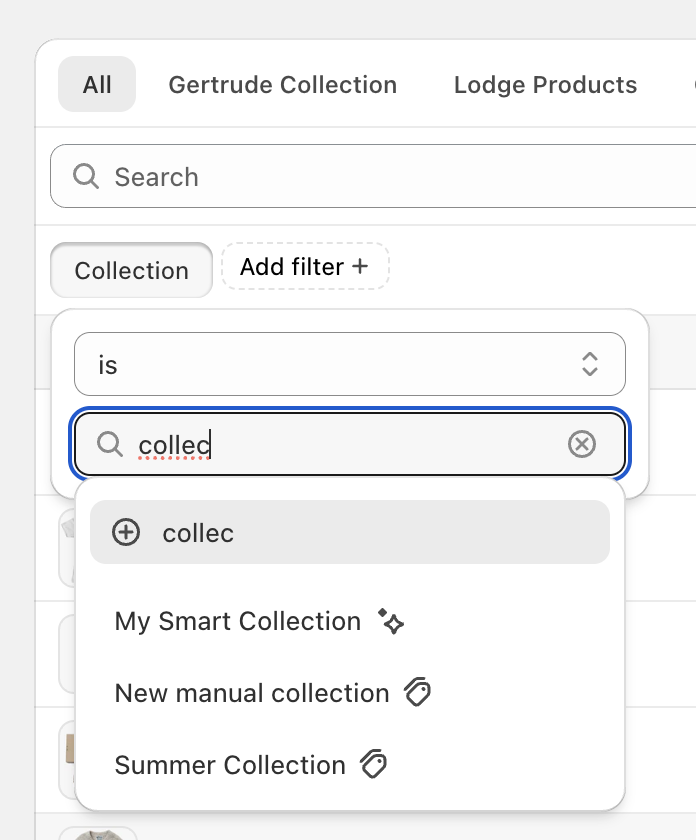
Learn more about searching for products to bulk edit.
Published on 2025-03-06
On March 8, starting at 05:30 UTC, we will be performing database maintenance which will result in the Shopify apps being briefly unavailable. Scheduled tasks will run automatically once the maintenance completes but bulk edits running during that time may be interrupted and need to be restarted. We are trying our best to schedule the maintenance during periods of low usage, if you have any questions please reach out.
14 February 2025
Published on 2025-02-14
We've upgraded the Shopify APIs that are used to bulk edit product categories. For the most part these changes should be transparent however there are a few things to note:
- The 'Product category' field is now renamed to 'Category' to stay consistent with how Shopify calls it
- Recurring edits, code snippets, and product rules that are configured to use the old category IDs should continue to work
- Code snippets now have access to a
taxonomy_categoryfield where you can see the category in Shopify's product taxonomy format.
Learn more about editing product categories.
13 February 2025
Published on 2025-02-13
We've made a large update to how we handle product images across our apps. While you shouldn't notice any immediate changes, this paves the way for supporting additional types of product media like external videos and 3d models. If you do encounter any issues product images not updating in our apps please let us know and we'll get them fixed right away.
If you are using Ablestar Bulk Product Editor you may need to update the app's permissions for edits to work. You can do this by going to the Settings section of the app. If you see a yellow banner prompting you to update the permissions follow those steps.
6 February 2025
Published on 2025-02-06
We've made two improvements to importing products with Ablestar Bulk Product Editor:
- When you configure the fields to map into Shopify we now display the column letter on the left. This can help when mapping files with a large amount of columns
- When the app encounters an error creating a product on Shopify (for example if you're trying to set a numeric metafield to a value like "shoes") the app will display that error message immediately and the row number from your file.
Together these should make it easier to configure and import product data. Learn more about creating products in Shopify.
5 February 2025
Published on 2025-02-05
Because of changes to Shopify's API, it is no longer possible to directly edit the Fulfillment Service field for product variants. Originally, variants could only be stocked with a single fulfillment service, and you could bulk edit that field through the app.
With changes starting in 2022, variants can now be stocked at multiple fulfillment services. As a result, the upcoming version of the Shopify API has removed the ability to modify the Fulfillment Service field.
As a replacement, you can connect or disconnect the variants from specific locations managed by different fulfillment services.
Learn more about connecting and disconnecting inventory locations.
28 January 2025
Published on 2025-01-28
We've improved the edit logs when running an inventory level edit. Now, the location of the inventory will be shown to the right of the 'Inventory Level' label. This will make it easier to see what data has been changed, especially if the edit is updating multiple inventory levels at once.
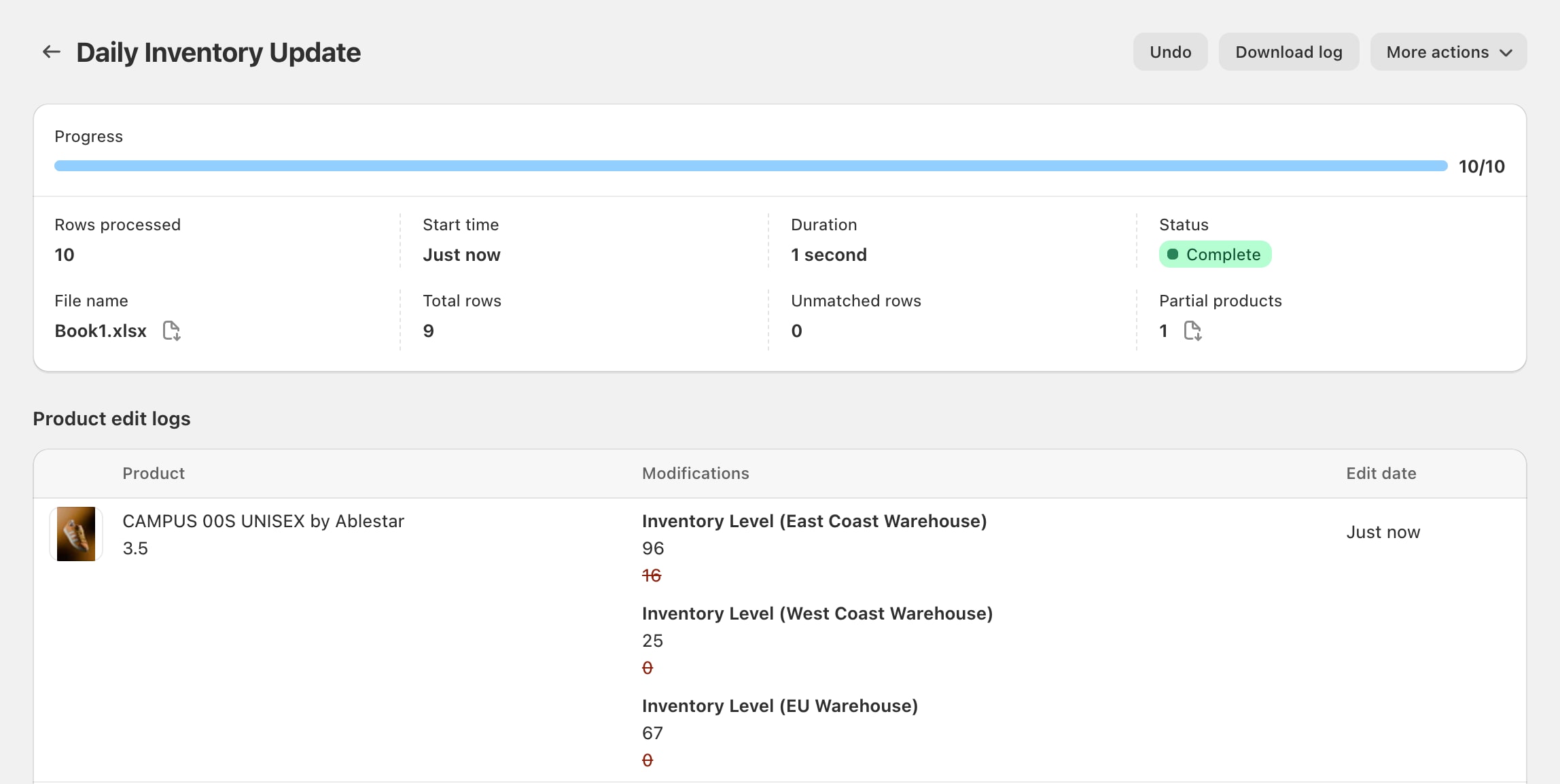
Learn more about editing inventory levels.
28 January 2025
Published on 2025-01-28
We've added a 'Download log' button on the price history page which allows you to download a CSV file of the product's price history:
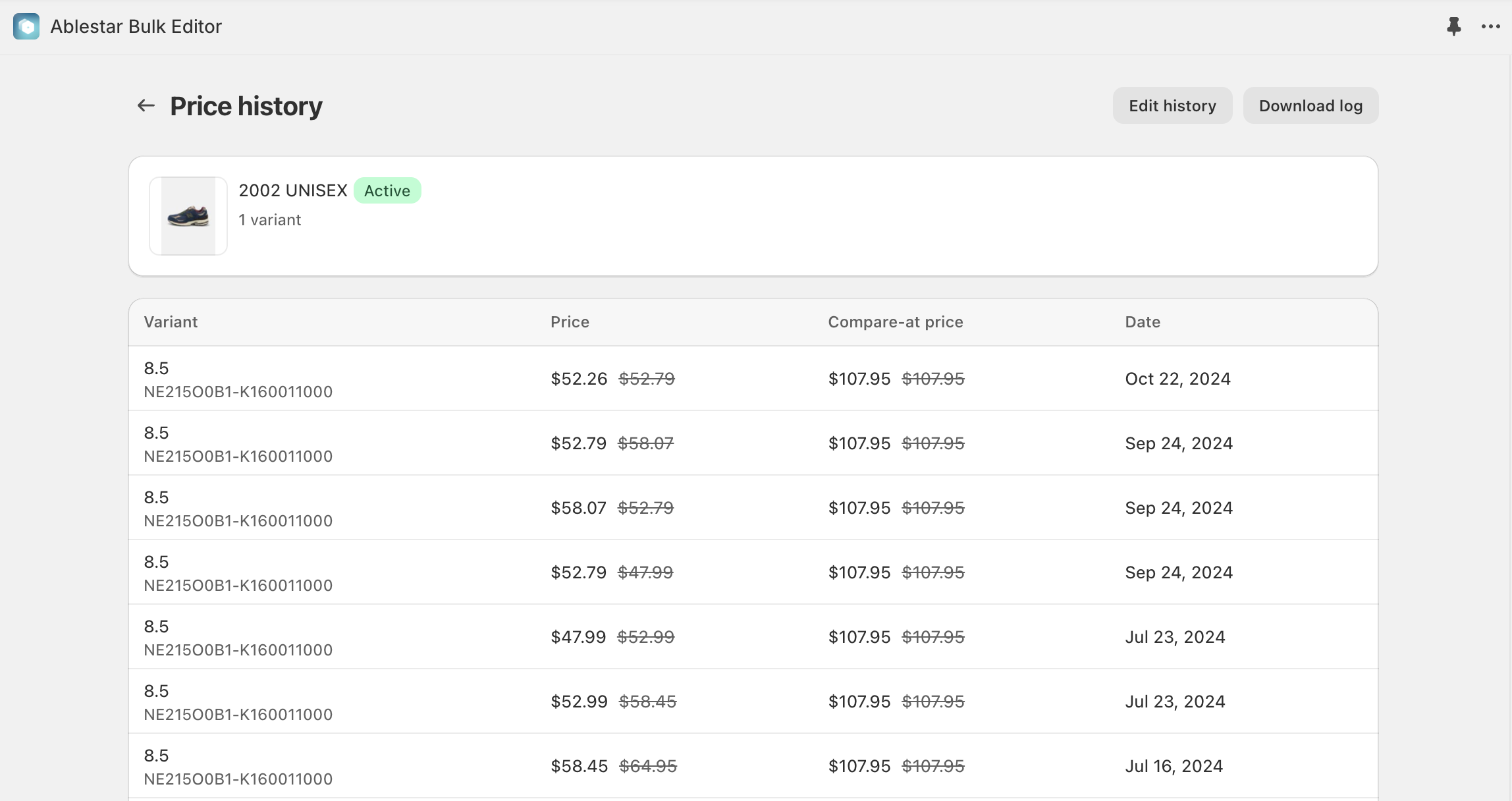
As a reminder, the price history page will show you all price changes that have occured while the app is active, not just changes that occured in the app. You can access the price history page by:
- Navigating to the product or variant in the Shopify admin
- Clicking on the More actions button at the top of the page and selecting Price history
Learn more about viewing a product's price history in Shopify.
24 January 2025
Published on 2025-01-24
You can use product rules to automatically enforce actions on your products—such as archiving any items that are out of stock. However, because of this flexibility, it's also possible to create rules that loop, continuously toggling a product between two states. To prevent these loops, Ablestar Bulk Product Editor automatically pauses any rule that runs too frequently on a single product.
We've made it easier to identify which product triggered a pause. When you view the details of a product rule, you’ll see a link to the affected product and its edit logs. Reviewing these logs can help you determine what caused the product to be edited too many times.
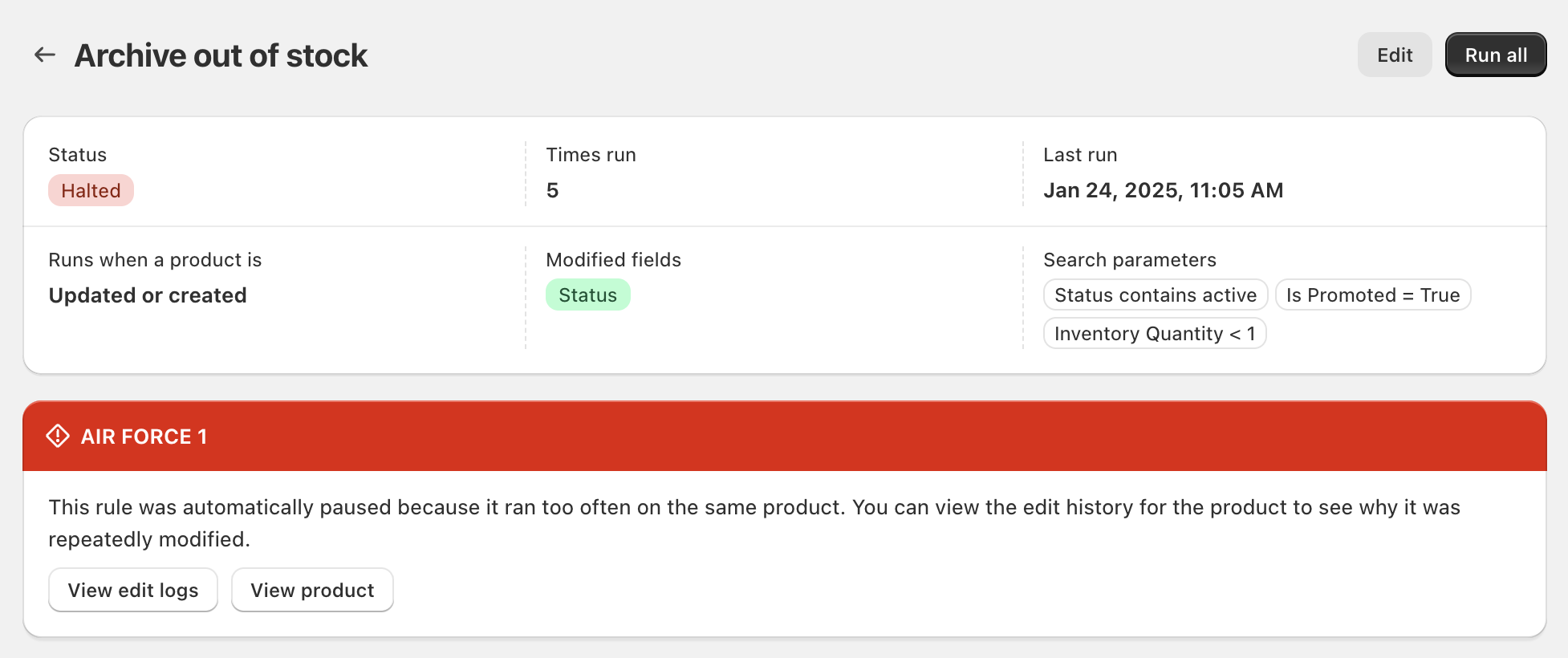
Learn more about product rules.
23 January 2025
Published on 2025-01-23
We've updated Ablestar Bulk Product Editor to make it easier to bulk edit an arbitrary list of products. Now, if you select Specific products under the '+ Add filter' dropdown, you'll see a popup window where you can quickly select multiple products by title:
This should speed up the process to select specific products when they aren't easily identifiable by other fields.
Learn more about searching for products to bulk edit.
23 January 2025
Published on 2025-01-23
When you run a spreadsheet edit in Ablestar Bulk Product Editor you have the option to limit the spreadsheet to a specific vendor. When you select the vendor the app will analyze the file to see how many products match each row.
Previously, this analysis could take several minutes, especially on stores with a large amount of products. We've made some changes that should significantly improve the speed of this analysis, allowing you to set up your edits even faster.
9 January 2025
Published on 2025-01-09
You can now connect products to multiple locations in a single modification. Previously, if you wanted to connect products to multiple locations in a single edit you would have had to click on '+ Add modification' to include each new location. Now you can do this simply by selecting mutliple locations from the dropdown. The same process applies for disconnecting inventory from locations.
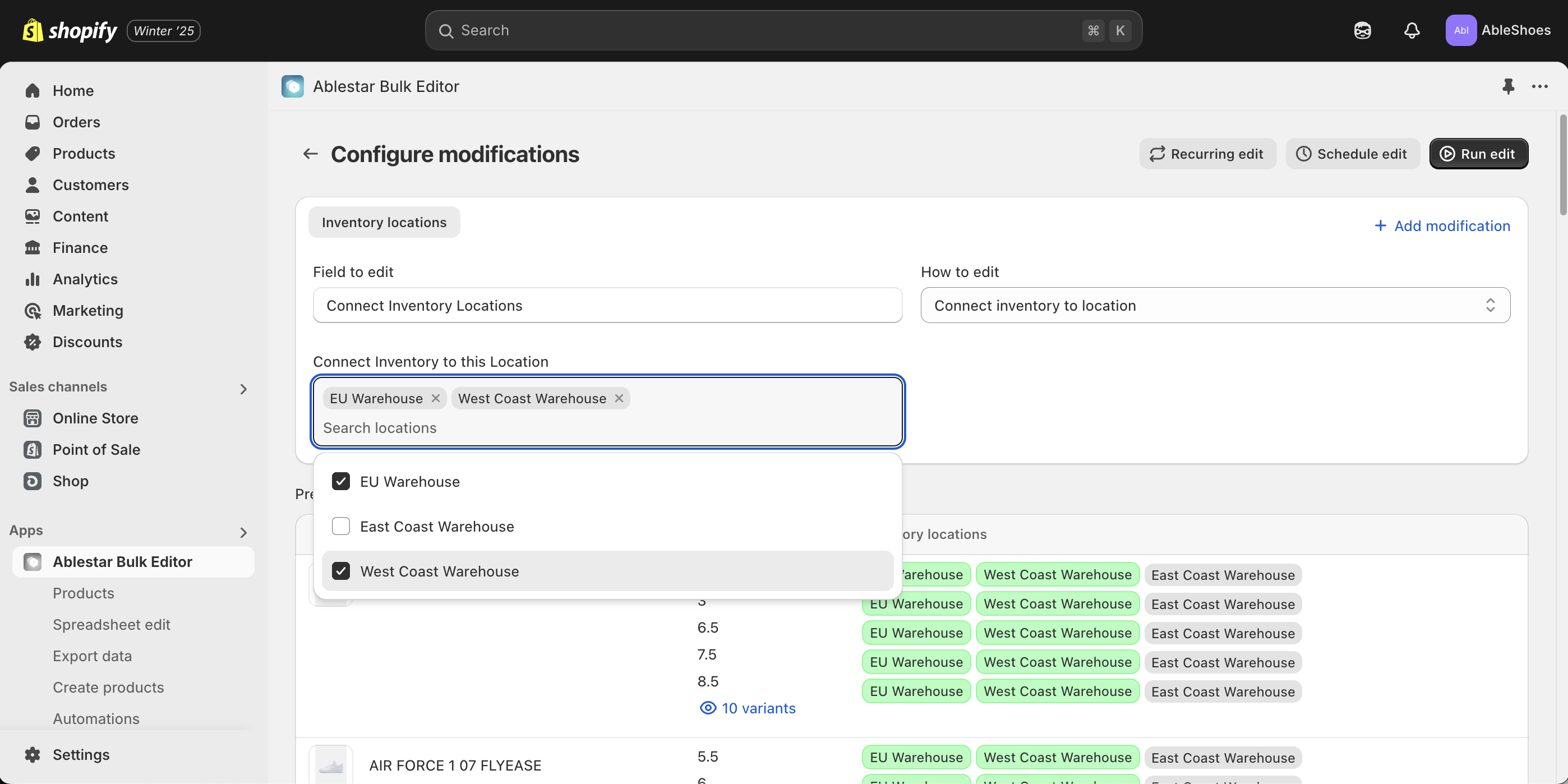
Learn more about connecting inventory to locations in Shopify.
22 November 2024
Published on 2024-11-22
We've improve the 'Configure modifications' page to make it easier to configure edits with just the keyboard. Now, the app will switch the highlight to the next field automatically and we've also improved the order of tabbing between elements.
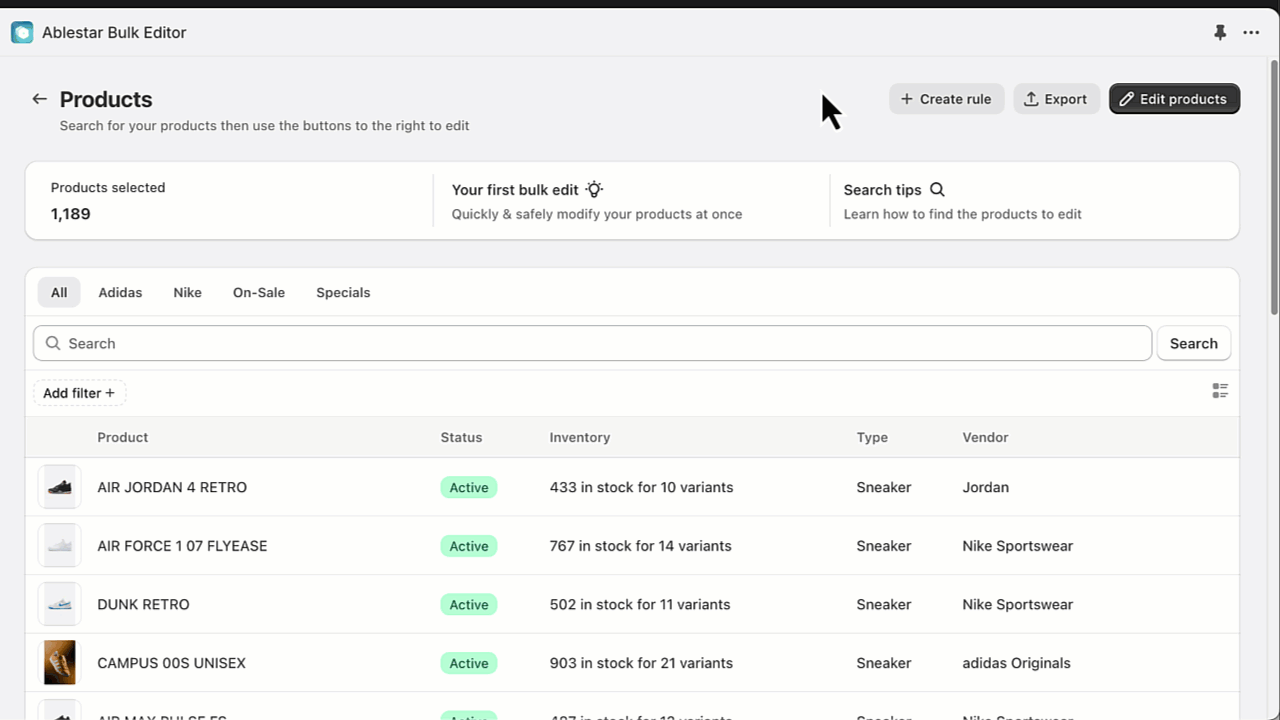
15 November 2024
Published on 2024-11-15
We are establishing a code freeze between November 25 and December 6. During this period we will only deploy critical fixes to our Shopify apps.
The idea behind a code freeze is to reduce the possibility of introducing bugs and unexpected system interactions that could cause problems during the peak holiday shopping days.
After December 6 we will resume deploying changes as usual.
13 November 2024
Published on 2024-11-13
We've improved the autocomplete when searching for products by their theme template. Using the autocomplete you can quickly search for products assign to a particular theme template or products that aren't assigned to any template (the 'Default product' template).
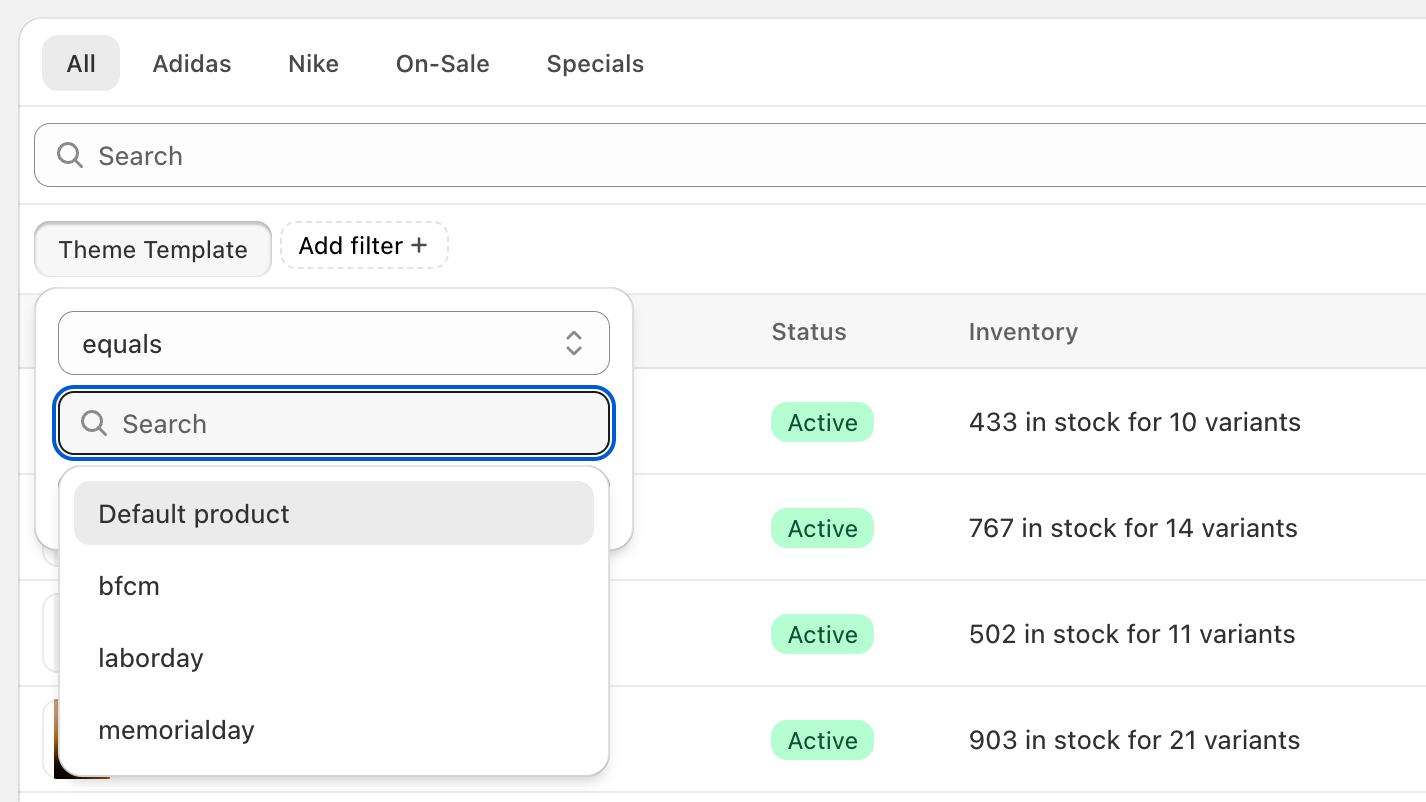
Discover more search tips for Ablestar Bulk Product Editor.
12 November 2024
Published on 2024-11-12
We've made it easier for you to learn more about the fields you're trying to edit. Now you can access documentation for a field directly from the app:
- For an in-app edit, click on the link below the 'Field to edit' button
- For a spreadsheet edit, click on the (i) icon to the right of the field selector button
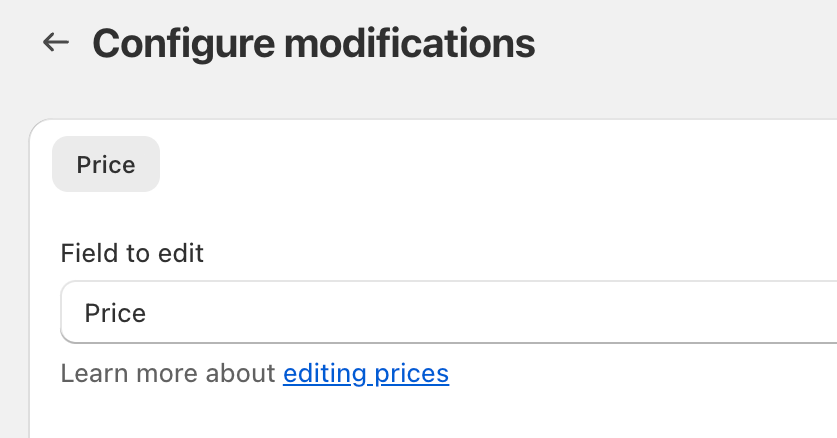
This quick reference should make it easier to learn editing options and formats for specific fields and we're continuing to update our documentation to cover all field types.
See a complete 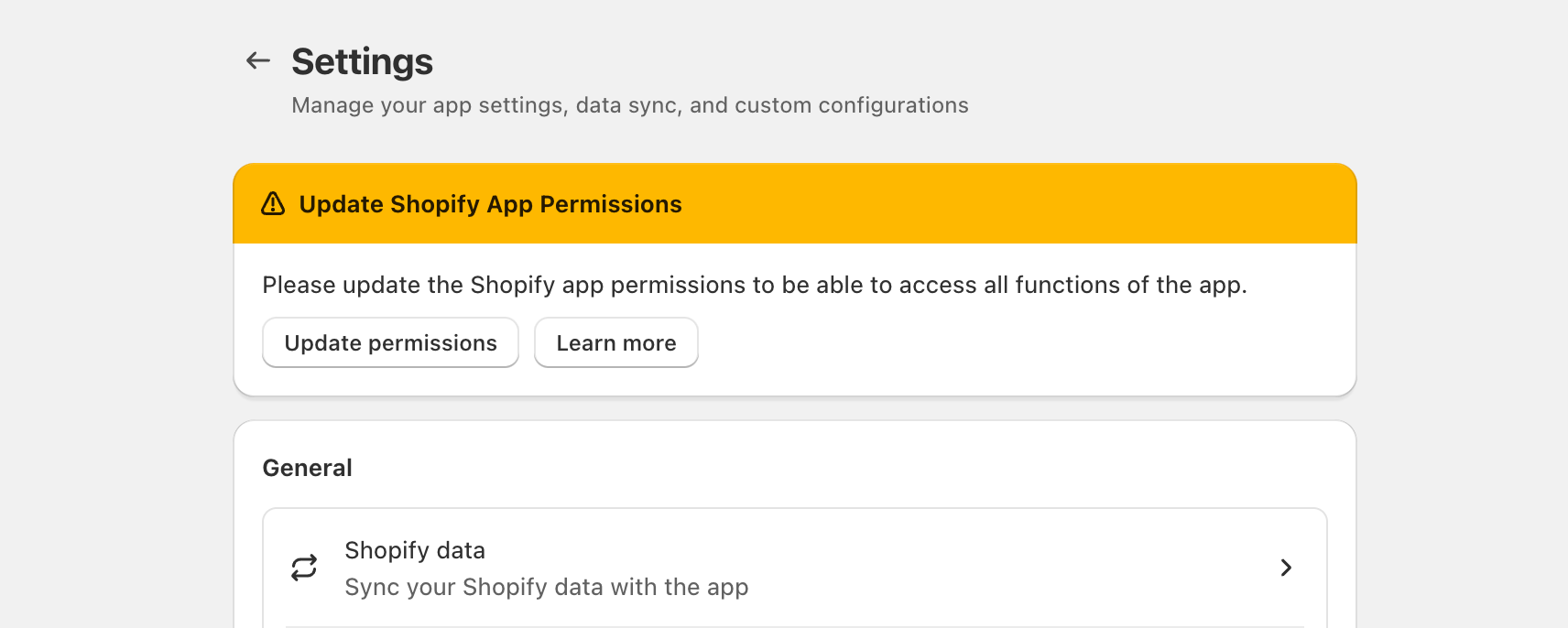
Learn more about updating Shopify app permissions.
6 November 2024
Published on 2024-11-06
As of January 13, 2025, we will be officially deprecating the old fullscreen version of Ablestar Bulk Product Editor. In July 2024 we launched a new version of the app fully integrated into the Shopify admin. While most users are already using the new version, those still using the fullscreen version will be switched over on January 13.
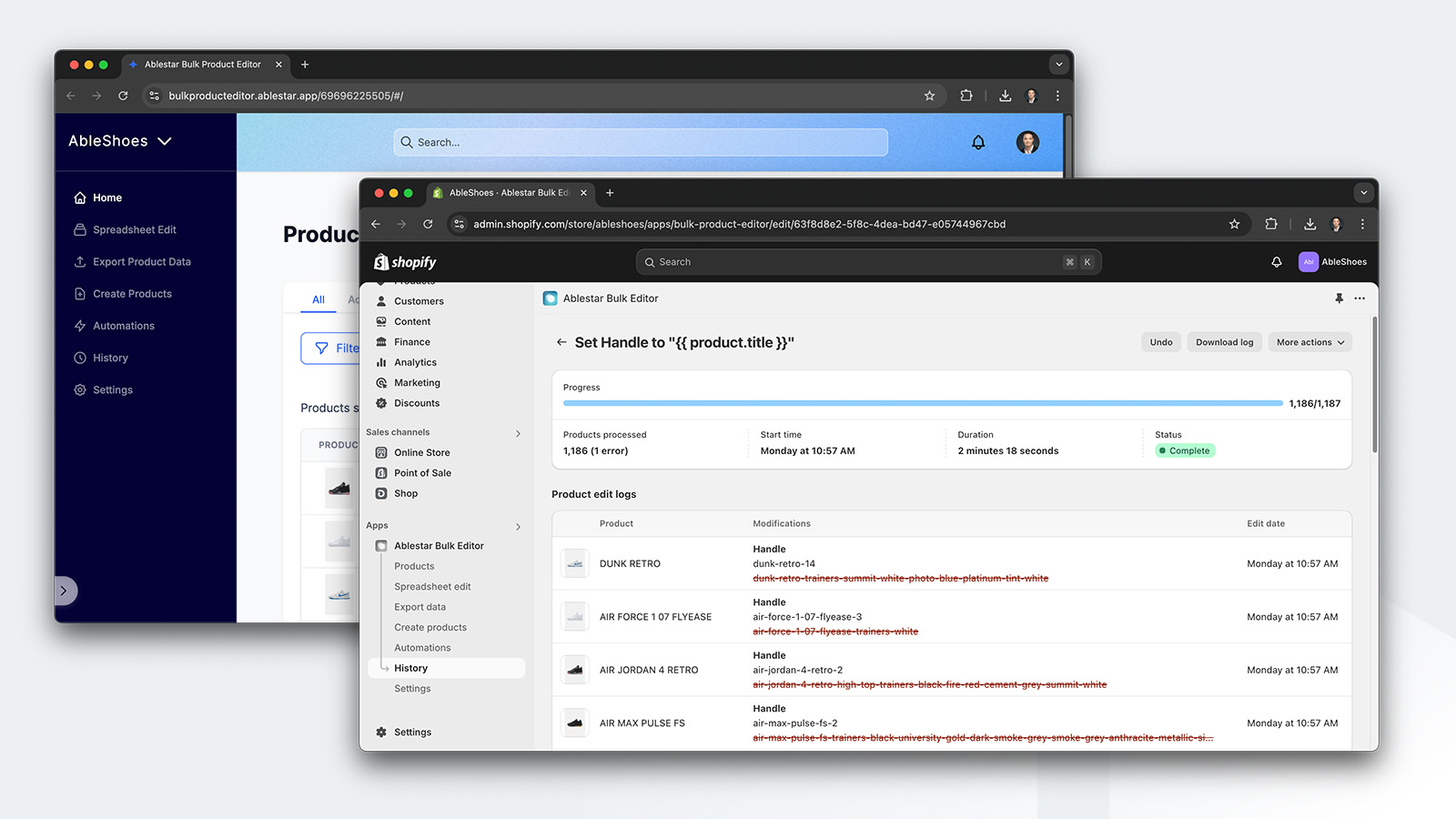
If you encounter any issues or notice differences between the two versions that impact your workflow, please reach out to us. We want to ensure the embedded app meets all your needs and are open to improvements based on your feedback before the final transition.
Thanks for making this shift with us—by just having to support a single version of the app we'll be able to focus more on delivering new features and improvements.
5 November 2024
Published on 2024-11-05
You can now save an edit as a favorite, making it easy to access later. To save a favorite:
- Open up the edit from the history page
- Click on More actions -> Add to favorites
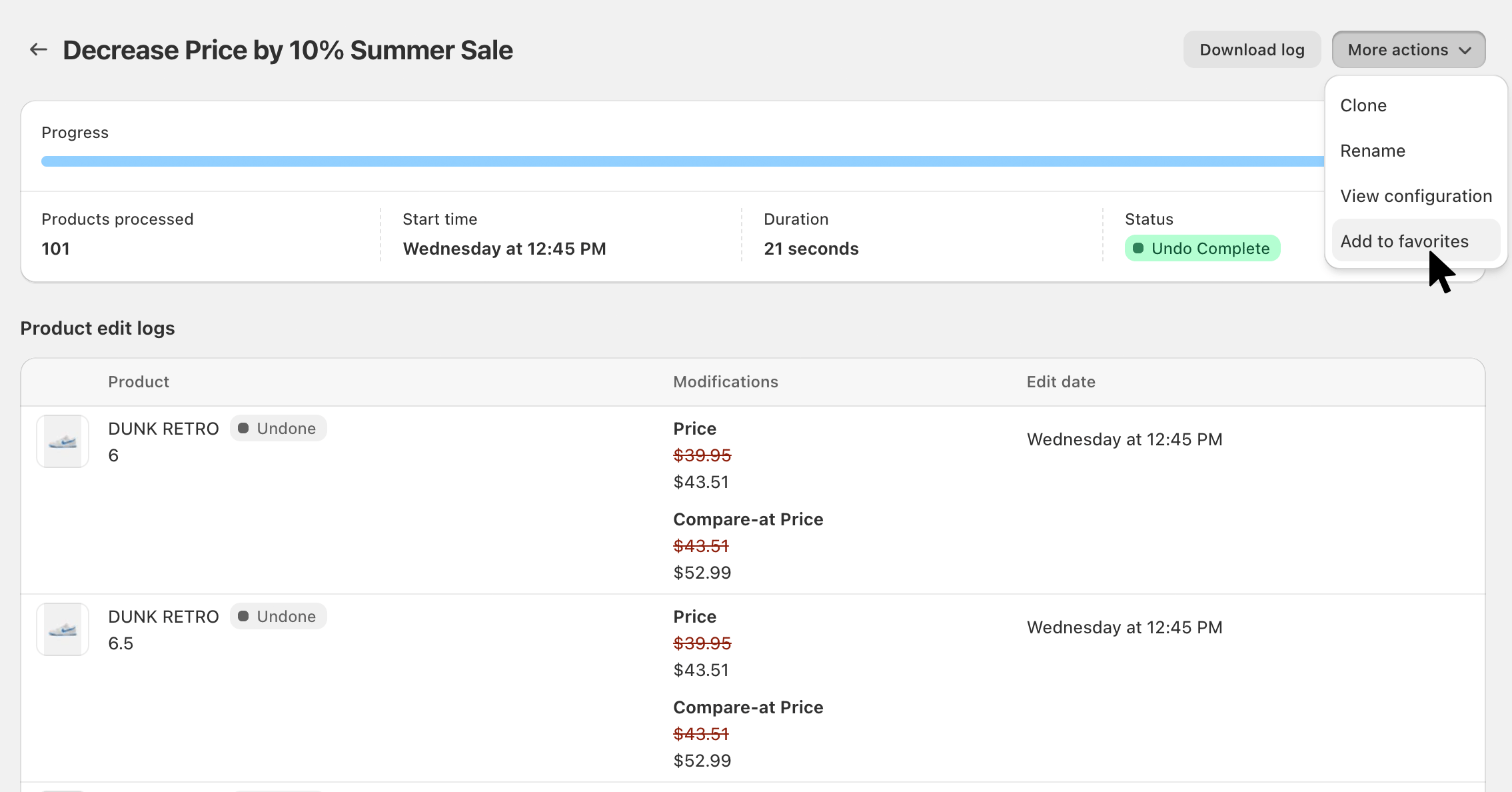
To view your favorited edits click on History in the left-hand menu and then click on the Favorites tab.


